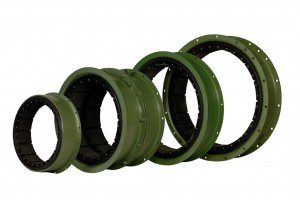 Ever wondered how air clutches work? K&L Clutch and Transmission has the expert answer!
Ever wondered how air clutches work? K&L Clutch and Transmission has the expert answer!
An industrial air clutch for heavy machinery performs a very important job in relation to an engine and how power or torque is transferred. A typical engine has an output shaft as can be seen on an automobile engine at the flywheel position. A clutch is a device, usually a system of plates or grabbing disks that engage the power from the flywheel and transfer it to the transmission. A PTO, or power takeoff shaft, performs the same function and is commonly found on heavy construction equipment or farm machinery. The engine clutch engages with the PTO shaft so that it may spin or drive another component, like a tiller or peripheral device. Compressed air is used to engage or disengage the engine from the driven component, rather than using hydraulic (oil) or centrifugal force.
Pneumatic Air Clutch Design Function
An air clutch uses compressed air or other gases to regulate the contact between two power shafts. Nearly all clutch systems use some type of pressure springs which assist in engaging and disengaging the clutch. First, a signal is sent via a sensor when a shifter mechanism is activated to engage the clutch. It sends this signal to the control unit which activates a magnetic valve assembly. Compressed air is then routed through the valve and to the clutch which engages it, coupling the two shafts. In some cases, the more air allowed in through the valve can cause an up-shift through several higher gears. A reduction in air can downshift the mechanism. The compressed air can originate from an on-board compressor tank or come from a special routing from the engine’s exhaust system.
Industrial Air Clutches
Air clutch systems come in numerous designs and technologies. Two such clutch designs are the Twin Disc clutch and the Oil States clutch. Wrap spring clutches coil and uncoil to transfer torque from an input shaft to an output shaft. Ball detent air clutches use a feature to dislodge seated balls when under load so they can overcome air pressure engagement or heavy compression springs. Roller detent clutches have rollers locked in place by springs, and when activated wedge between an inner and outer race to make a power connection.
Vehicle Air Clutches
A typical vehicle clutch is disengaged upon application of the clutch pedal. This opens an air valve, pushing air into a rotary inlet inside the shaft. A pneumatic throwout bearing is activated, releasing contact pressure between the flywheel and pressure plate assembly, causing the clutch to open. Releasing the clutch pedal purges the air out of system which allows the springs to force contact and complete the power connection.
Air Clutch Advantages
Compressed air requires little maintenance, is cleaner than hydraulic systems and is easier to handle. The torque control of a pneumatic clutch is generally more accurate than a mechanical clutch, usually operating at a 5 percent variance or less, as opposed to the mechanical types that operate at 10 percent variance. However, the integrity of the fittings and lines must be maintained to avoid leaks and loss of air pressure in the system. If you’d like to learn more about how air clutches work, or have a question about specific names, like Twin Disc clutches or Oil States clutches, contact K&L and we’ll answer your questions!

























